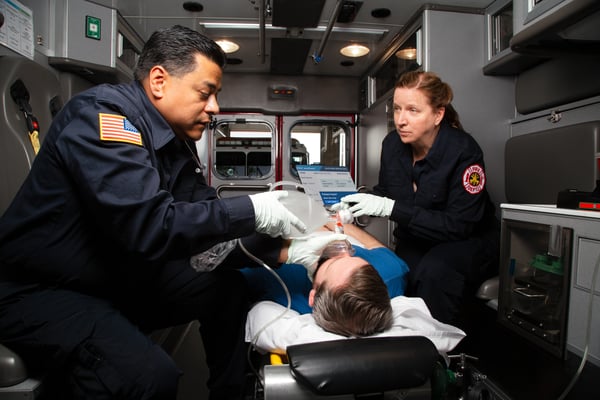News Alert: New ePCR Integration Simplifies EMS Data Management and Enables Better Care Coordination
Focus On These 7 Essential Elements To Produce High-quality ePCRs
Make sure to document these seven ePCR narrative elements for every EMS encounter.
Was this information valuable?

Updated: April 29, 2025
Today, the need for EMS clinicians to write and maintain accurate, high-quality, and detailed documentation has been a big focus in the industry. It is crucial for clinicians to ensure that their documentation of patient interactions is documented in a precise manner. Electronic patient care reporting (ePCR) software can help produce great documentation, but only if the data input is accurate, thorough, and of sufficient quality. Keep in mind that “garbage in = garbage out.”
One area of documentation where providers have a significant amount of input is the narrative. One of the biggest benefits of ePCRs is the unlimited space given to providers to write their narrative. Some “seasoned” providers may recall how difficult it was to cram an entire narrative into 10 or 20 lines on paper forms. Even for those who could write neatly, it still proved to be a challenge. Providers can now write a narrative without confining it to a few lines. The biggest questions now are, "What do I write in my narrative? What should be included? What should I not include?"
How To Write Your Narrative To Paint a Complete ePCR Picture
There are many different formats available to providers that can guide narrative documentation. Here are some examples of common narrative approaches:
- Subjective, Objective, Assessment, Plan (SOAP):
- The subjective portion of the narrative goes over the history of the incident (what you’ve been told)
- The objective portion of the narrative describes your assessment findings, or other key observations
- The assessment portion of the narrative covers your diagnosis
- The plan portion of the narrative depicts what you did to treat the patient
- Subjective, Objective, Assessment, Plan, Intervention, Evaluation, Revision (SOAPIER):
- Takes the SOAP method and adds three additional steps:
- Interventions or implementations of care given
- Evaluation of the effectiveness of the response
- Revisions made to the original plan of care
- Takes the SOAP method and adds three additional steps:
- Complaint, History, Assessment, Rx, Treatment (CHART):
- Start with the chief complaint
- Perform a History of Present Illness (HPI) exam, including a patient’s past medical history
- Document your assessment findings
- Identify what prescriptions (Rx) the patient is taking
- Outline what treatment you have given the patient
Over the years, the need to include additional information that doesn’t fall neatly into one of these acronyms has grown significantly. If you extend this beyond the typical 911 EMS call and look at documentation on acute, non-emergent routine transfers, it may seem like you are putting together the components of a doctoral dissertation. No matter what your preferred approach is, understanding and documenting key elements of the call in the narrative will take your documentation to the next level. The foundation for a high-quality narrative is already there, in the run itself. EMS providers just need to pull the information together and write it down in a way that paints a clear picture.
Here are seven essential elements for documenting a well-written and complete narrative:
1. Dispatch and Response Summary. Provide explicit details about where the unit was dispatched, what they were dispatched for, and on what priority. Include a short description of the response itself: Did the unit arrive without incident? Was there a change in response mode?
2. Scene Summary. Detail what happened when the crew arrived on scene. What did the scene look like? Where was the patient found, and in what condition? What was your initial impression of the patient?
3. HPI/Physical Exam. Detail the initial exam upon patient encounter to establish the patient’s baseline.
4. Interventions. List all interventions. What did you do to, or for, the patient? Interventions may include vital signs assessed, oxygen via NRB at 15 lpm applied, IV initiated, medications administered, etc. If your ePCR system allows you to detail interventions elsewhere, then provide a brief overview here.
5. Status Change. Document any change in the patient’s condition. What changed, and what was done about it? In some situations, there may be significant changes to the patient’s condition, and you may need to re-document a physical exam, interventions, or status change.
6. Safety Summary. Provide details about how the patient was transferred from the scene to the stretcher and then to the ambulance. Document which safety measures were performed, such as using safety straps while transferring the patient. Also include what position the patient was in during transfer and any other relevant information, highlighting how you kept your patient safe during transport.
7. Disposition. Detail the transport from the scene to the receiving facility. Like the response summary, document which facility you transported the patient to and with which priority. Was there any entry notification, or was a code team such as a Trauma Team or Code AMI Team activation requested? This section also provides details about what happened at the receiving facility. Where was the patient left? Who was care transferred to? Was a report given, and to whom? Were there any patient belongings transferred? Who received them?

As clinicians, EMS providers have a responsibility to provide high-quality, accurate, and detailed summaries of all patient encounters. Fortunately, software like ZOLL® emsCharts® and its mobile companion app, ZOLL emsCharts NOW, offer a variety of tools to help make documentation easier and more complete. The seven essential elements for high-quality ePCRs discussed here are designed to help providers identify what is crucial to document for every encounter, providing a strong framework for their narrative.
Related Posts
How STAT MedEvac Connected Device, Software, and Data Technology To Enhance QA and Elevate Care
Podcast: 4 Ways ePCR Software Can Relieve EMS’ Biggest Headaches
ZOLL Pulse Blog
Subscribe to our blog and receive quality content that makes your job as an EMS & fire, hospital, or AR professional easier.
ZOLL Pulse Blog
Subscribe to our blog and receive quality content that makes your job as an EMS, fire, hospital, or AR professional easier.




